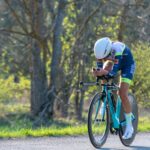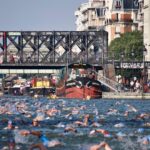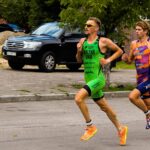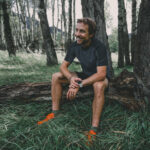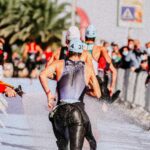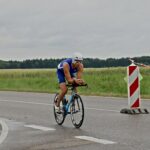Note: After publishing my “Eight Must-Haves” on 12/28/20, I have added two more Must-Haves that I wanted to share.
“Hi, my name is Jim and I’m obsessed with triathlon.” Yes, I admit it, I am 100%, over-the-top crazy about triathlon (that’s what my family thinks!).
A brief back story explaining how I arrived at this place of total absorption and immersion in our sport. In the early 2000s, after achieving my goal of going under three hours in a marathon, I transitioned to triathlon and jumped right into and completed two Ironmans and a number of half-Ironmans. In 2008, in the early stages of raising two daughters, I lost my competitive mojo and stopped racing (I continued to bike and run for fun and fitness, but didn’t do a lap in a pool during this hiatus). During the next 11 years, I thought it would be fun to return to triathlon, but that theory never translated into reality. Then, in the summer of 2019, that mojo inexplicably came roaring back suddenly. I started training again (I was just making up my program as I went along), raced four races that summer and fall, and was excited for the 2020 race season. Then, of course, Covid-19 struck and my triathlon plans were derailed. I did get three races in, but my “A” race, the USAT Age-group Nationals, was cancelled. My passion for triathlon was fueled, rather than dampened, and my enthusiasm turned to obsession.
I began looking for ways to train better and get faster. I have spent countless hours scouring the internet for information that both inspired and educated me. I read hundreds of articles and, most significantly, I discovered Global Cycling Network and Global Triathlon Network on Youtube (my life has been transformed forever!). I was like a wild and ravenous triathlete consuming everything in my path. Over the course of 2020, as a part of this hunger for all things triathlon, I began accumulating what I consider to be the “Ten Must-Haves for the Obsessed Triathlete in 2021.”
Before I dive in, let me make clear that I receive no financial benefit from “endorsing” any of the following must-haves. I paid for all of them and highlight them because I believe that they are best out there (though others may have differing opinions).
Must-Have #1: Training Watch
I realize that this must-have isn’t exactly a revelation. The fact is that most triathletes, however serious, have a training watch. But, as I began looking for the ideal watch for my needs (and obsession), I learned how much a good training watch can bring to the triathlon experience. The different forms of data that I could gather and use in my training expanded exponentially: HR, mph, minutes per mile, cadence, stroke length, stride length, SWOLF, sleep, training load, intensity, training zones, the list goes on.
I’m a guy who does extensive research before I buy something (I have more time than money!), so I dove head first into reviewing all of the top brands. Of course, we all know Garmin, Polar, and Suuntu, and they all make outstanding training watches. But I decided on a newcomer to the training watch market, the Coros Apex, for several important reasons. First, the watch is as feature-rich as the other brands. Second, it has only two buttons which means a lot less confusion and pushing the wrong button. Third, their tech support is fast and professional. Fourth, Coros actually listens to its customers and makes software updates quickly in response. Fifth, the Apex actually looks attractive and can be worn as a regular watch. Sixth, the Apex was $200 less than comparable watches by its competitors. Lastly, Coros makes the Apex in a 42mm size, which is ideal for slim-wristed people like me (I don’t have to walk around with what looks like a hockey puck strapped to my wrist!).
Must-Have #2: Heart Rate Arm Band
If you have a training watch, it probably has an optical sensor which can seem to be useful for tracking your heart rate during your training efforts (and throughout the day). Unfortunately, in my dozens of reviews of watches, it is widely held observation that the wrist-based sensors don’t provide reliable heart-rate data. These findings certainly confirmed my own impressions in which I saw incredible inconsistency and fluctuation in my HR during training, especially while swimming. Reviewers indicated that optical sensors don’t typically provide great HR accuracy, but, more importantly, having the sensor situated on a wrist, far from the heart, was the primary culprit for inaccuracy.
So, I did what most triathletes do, I bought a chest-strap HR rate monitor (in particular a Garmin HRM-Tri), considered the gold standard for HR because it uses a sensor that measures electrical impulses nd because it’s located close to the heart. However, every triathlete who has used a chest strap knows how much of a nuisance they can be. They can be either too loose (and slip down) or too tight (and cause chafing). Seeing triathletes constantly pulling up their chest straps is a common sight. Chest-based HR monitors also can’t be worn comfortably or effectively while swimming, when HR accuracy is especially challenging.
I was certainly dissatisfied with my chest-strap monitor, so I returned it and went in search of another option. I soon discovered the emergence of so-called HR arm bands, of which the Scosche Rhythm, Wahoo Tickr Fit, and Polar OH1+ are the most popular. As is my want, I researched the heck out of HR arm bands and landed on the Polar OH1+ for several reasons. First, it is as or more accurate, according to several reviews, compared to the other two. And some have reported that it is as reliable as chest straps. Second, it is the smallest and lightest of the three. I place it above my elbow (can’t slip down) and I don’t even notice it. Third, it can be removed from the arm band and placed in a clip that attaches easily to your swim-goggle strap. Some key advantages to this over-arm placement: It is above water more often (compared to wrist- or arm-based monitors), it measures HR from the temporal artery, and it can’t slip down. Fourth, it has a slightly lower price point.
Must-Have #3: Power Meter
For the first year and half since my return to triathlon, I was basically flying by the seat of my pants (as the saying goes) in terms of my training. I tracked my heart rate, but didn’t do anything with the data. I used Rate of Perceived Exertion (RPE) as the only monitor of the intensity of my training. It seemed to work okay, but, because I love training so much, I would often just hammer too much and recover too little, until I was completed cooked and needed to take extra time off.
It became clear from my two summers of triathlon racing that my strength is my running, my weakness is my swimming (I grew up in the “non-drowning” category of swimming), and my cycling was the area in which I could make the most significant gains. It also became clear that I needed a better metric than RPE or HR to guide my cycling training.
I have known about power meters for years, but they seemed so unnecessary and, well, indulgent, that is, until my obsession with triathlon took hold of me. I realized that if I wanted to achieve my triathlon goals, I needed power data to direct my training efforts on the bike. So, as is my style, I researched power meters. I learned that there are spider power meters, crank arm power meters, pedal power meters, spindle power meters, power pod power meters, and more. I also learned that they are darned expensive!
After reading many reviews, I learned about the strengths and weaknesses of each type of power meter and their associated brands including 4iii, Favero, Garmin, Stages, Quarq, Powertap, Rotor, and Power2Max. I ended up buying the Quarq DZero for several reasons. First, it has the reputation as the gold standard of power meters. Second, Quarq has been found to be incredibly accurate. Third, it measures power in both legs (as compared to other PMs that only measure one side). Fourth, it doesn’t require buying an entirely new crank. Fifth, Quarq is owned by SRAM which meant easy integration with SRAM etap groupset that I have on both my triathlon (Diamondback Andean 3) and road bike (S-Works Venge). Sixth, Quarq has amazing customer support (Alex M., Alex P., and Jonny are rock stars!). Lastly, the price point was reasonable (as far as power meters go).
Must-Have #4: Training Platform
If you’re like me, collecting all of that valuable data is part of the value and fun of the aforementioned watches, HR arm bands, and power meters. The question that I’ve evolved into an answer for is: Where do I put all that information? More specifically, which training data platform should I use? There are, of course, many to choose from. Coros, and every other training watch, has it own proprietary platform that not only offers a place to put your data, but also provides analytics and metrics for volume, intensity, fitness gains, recovery, and much more. There are also a variety of stand-alone platforms you can use. I started with Endomondo (I was mostly running then), evolved to Strava, and then, when I got really serious, began to look at the heavy hitters of training platforms including Azum, Today’s Plan, TrainingPeaks, Final Surge, SportTracks, Perfect Pace, and TrainerRoad.
Again, after extensive research and recommendations from several of my clients (I’m a mental coach who works with world-class endurance athletes), I chose TrainingPeaks (TP) for several reasons. First, it was created by Joe Friel, a legendary endurance-sport coach who founded the company more than 20 years ago. Second, TP is widely held as the gold standard among world-class athletes, so if it’s good enough for them, it sure is good enough for me. Third, its analytics are well grounded in the latest sport science. Fourth, it connects and shares training calendars and workout data with just about every other training platform. Fifth, TP was recommended by my new triathlon coach (more on that below). Finally, it is very reasonably priced, particularly given all it offers.
Must-Have #5: Virtual Indoor Cycling Platform
This must-have has been a game changer for every serious triathlete and cyclist. In generations past, riding an indoor trainer meant staring at a wall, watching movies, or listening to music, all insufficient for most of us to dull the raging boredom of literally spinning our wheels and going nowhere.
Oh, how times have changed. The development of virtual-reality technology has allowed a number of virtual indoor cycling platforms to provide riders with an indoor cycling experience that is immersive, engaging, informative, social, competitive, and downright fun to the point that there are some cyclists who would rather ride in their virtual worlds than on the roads and trails of the real world (plus, you can’t get hit by a car in Watopia).
For the past several winters, I’ve been living in the Sierra Nevada mountains of Northern California (my daughters are alpine ski racers who attend school up there) where, in 2019, it snowed 24 feet…in February! Needless to say, indoor training is a necessity. Last winter, before I had the data available from a power meter, I watched a lot of GCN shows and training videos on my laptop, which helped a lot. But it still was pretty darned boring. So, back in November, I did a “tour” of the best known indoor cycling platforms to see which one was best for me. I did free trials of Zwift, Rouvy, RGT, Trainer Road, The Sufferfest, and FulGaz. All bring unique aspects to the indoor cycling experience including training groups, augmented reality, real rides from around the world, pace partners, group rides, e-racing, cycling data, structured workouts, integration with training platforms, and gamification.
In the end, I chose to sign up for Zwift, not that surprising given that it is the most popular indoor cycling platform out there for several reasons. First, I found it the easiest to set up and use every time I rode (in contrast, Rouvy required me to download a ride before I could use it with one of my TrainingPeaks workouts). Second, it paired quickly with my power meter, cadence sensor, and HR monitor. Third, the layout of the riding screen was clear and helpful. Fourth, there was a lot to distract me from the boredom or pain of a workout.
Must-Have #6: Indoor Trainer
I have to admit up front that I’m still in the pre-acquisitional state of indoor trainers. I REALLY want to buy a smart trainer, but they are just a bit beyond my pay grade at this time given all my other triathlon costs. I currently use a CycleOps Fluid 2 “dumb” trainer. Though not at all intelligent, my Quarq power meters allow me to do about 90% of what a smart trainer can do and, at least at this point in my tri-life, it meets my indoor training needs more than adequately.
Nonetheless, I have, given my covetous state, researched them extensively and there are many quality smart trainers to choose from. In fact, they are all so good that I can’t say which I would buy at this point. Her are the most popular: Wahoo Kickr, Tacx Neo 2T, Elite Directo XR, and Kinetic R1 (here’s a nice review).
Must-Have #7: Tri-coach
Admittedly, the items so far are starting to add up to a pretty hefty outlay, all in the name of feeding an obsession and trying to get incrementally faster. But hiring a triathlon coach has been a huge boon to my training efforts. My self-guided training program was pretty good, I think, but what the heck do I know! Given that I have pretty lofty goals for this season (qualify for Age-group Worlds, however much of a fantasy that might be), I wanted someone who could really direct me on what to do, when to do it, how much to do it, and when to stop doing it and rest and recover. The ultimate goal of which is to prepare me optimally and allow me to become the fastest triathlete I can possibly be. Plus, I wanted a coach who would not only train me, but also satisfy my insatiable curiosity and educate me in the process.
There are, as you may know, innumerable triathlon coaches across the country and around the world, some local and others on the internet. Most of them appear to be knowledgeable and experienced. Yes, they can be expensive, but, if you’re committed to big triathlon goals, a good coach is worth their weight in gold. So, who to choose?
I ended up selecting Dr. Greg Rhodes, from Bend, Oregon, whom I had met through my ski racing work, for several reasons. First, Greg holds a Ph.D. in Exercise Physiology, so he clearly knows endurance sports in the deepest and broadest way. Second, he works with several Grand Tour pro cycling teams, meaning if he’s good enough for the pros, he is good enough for me. Third, Greg is an accomplished triathlete himself, so he also knows the realities of triathlon. Fourth, he is a really nice guy who is as passionate about human performance as I am (we can “talk shop” for hours).
Must-Have #8: Custom Kit
Okay, I admit that I may be pushing it here, but, well, that’s what I do in all aspects of my life. Let’s be realistic. Most triathletes buy their cycling and tri-kits off the rack or online, not paying too much attention to anything beyond comfort and color. Others are members of a triathlon team or club and proudly wear their kits. I was in both camps early in my triathlon life. But then I heard about custom kits that aren’t any more expensive than quality retail kits.
It used to be that a custom kit was an impossibility for individuals because companies required a crazy high number of orders to justify spending the design time and cost required to produce them. But, thanks to new design and production technology, costs have declined dramatically. Some of the leading purveyors of custom kits including some well-known brands such as Giordana, Louis Garneau, Capo, and Castelli, as well as niche brands such as BioRacer, Rapha, Pactimo, Cuore, and Endura (here’s a good review article).
I decided to go the custom kit route back in 2014 for a few reasons. One, I had been sponsored by PowerBar and rode with their kits for a number of years, but got dropped from their program, so I needed a new kit. Two, I didn’t find any designs that compelling while searching for kits on line nor did I have any strong affiliations with cycling or triathlon products that I wanted to promote. Three, I wanted to provide some professional self-promotion for my sport-psychology consulting practice. Lastly, admittedly, my ego thought it would just be fun to have my own kit design.
After doing my usual exhaustive research, I landed on Jakroo for several reasons. First, the quality of their materials were very high. Second, Jakroo had a minimum order of one item. Third, it had a wide range of templates to draw from. Fourth, the turnaround time from design to delivery was only two weeks.
I used Jakroo for the first time in 2014, collaborating with their designers to create a kit around my professional logo. The designers were amazing, creating a design that was “me.” I have ridden and raced with those kits for the last six years. Then, in the fall of 2020, I redesigned my logo and wanted my cycling and triathlon kits to match, so I re-engaged Jakroo. Once again, the collaboration was a huge success and I’m loving my new design.
Must-Have #9: A Superbike
Okay, now I’m REALLY pushing the envelope of must-haves for obsessed triathletes. I fully recognize that, if you added up the cost of my first eight must-haves, the price tag would not be insubstantial. I truly don’t mean to substitute “obsessed triathlete” with “wealthy triathlete.” And I also appreciate that not every triathlete can afford what they “must have” no matter how obsessed they are. Perhaps I should have called my top-10 list “Really Want to Haves.” At the same time, if you are truly obsessed with triathlon, as I am, you find ways to make it work within your budget.
Which leads me to Must-Have #9. There are some truly super triathlon bikes on the market including the S-Works Shiv, Trek Speed Concept, Canyon CFR, BMC Timemachine, Cervalo P5x, Dimond Brilliant, Orbea Ordu, Felt IA1, Ventum One, among others. They are all incredibly aerodynamic, sleek, sexy, fast beasts. They are also all incredibly expensive, with most topping out well above $10,000.
But, as I did my research, I learned that a superbike doesn’t need to be that expensive. I first learned this lesson back in 2019 when, in approaching a major birthday and not having bought a new road or mountain bike in more than a decade, I decided that I would treat myself to both as a special birthday present. But, though I earn a nice living, I just couldn’t see myself spending $25,000-$30,000 for two superbikes (nor could I explain this outlay to my wife who, though a cyclist too, just doesn’t value bikes in the same way I do). So, I searched on ebay for several weeks and found an 2018 S-Works Venge and a 2018 Trek Top Fuel 9.9 RSL, each with only a few hundred miles on them, for about half the retail price (still not a small sum, but manageable). Two years later, I can’t tell you how thrilled I am with both purchases.
This brings me to my “need” to get a super triathlon bike since I became obsessed with our sport. Though, in my research on triathlon bikes, I looked at all those I listed above, there was one bike I came across that was love at first sight and that I knew I had to buy: Diamondback Andean 3. Not only did the reviews suggest that it might be the fastest bike out there, but it is just really cool looking. But, again, a hefty price tag. I did find a solution however. I bought the frameset from Diamondback and then sourced and bought the components on ebay, and then had the bike built by my local shop. The total cost of my new superbike was around half the price of retail. And I can tell you that the Andean 3 is a rocket and, again, I absolutely love the bike and have felt zero buyer’s remorse since.
Must-Have #10: Trieye sunglasses
My last must-have for obsessed triathletes is the simplest of the eight, yet has had a truly immense impact on my cycling, most notably on my confidence and sense of safety while riding on the road. As every cyclist knows, riding on a busy road can be scary and downright dangerous. And, more specifically, not being aware of traffic coming from behind and having to turn your head and take your eye off of what is in front of you to see what is happening behind you. Or keeping an eye on who I’m riding with behind me.
For years, I’ve been looking for a good rearview mirror for cycling, but none that I found met two criteria that would compel me to buy it: 1) It works, meaning I’m able to see a large segment of the road behind me through the mirror, and 2) It doesn’t look geeky (admittedly, I’m a bit of a cycling snob). Of the two most popular styles, bar-end mirrors weren’t effective and clip-on mirrors are so uncool.
Then, back in 2018, I came across Trieye sunglasses while searching for cool cycling stuff that might enhance my cycling experience. I immediately ordered them for several reasons. First, what makes them unique is the rearview mirror is integrated into the lenses. I now literally never look over my shoulder while riding. I can see what’s happening behind me while keeping my eyes looking ahead (except for a brief glimpse into the mirror built into the Trieye lenses). Second, they fit comfortably, have high-quality lenses, and actually look good. Trieye clears the bar for both effectiveness and coolness. To be honest, I can’t believe that every serious cyclist or triathlete (and even not serious ones) doesn’t wear Trieye.
Do you want to take the next step in training your mind to perform your best in training and on race day? Here are four options for you:
- Read my latest mental training book: Train Your Mind for Athletic Success: Mental Preparation to Achieve Your Sports Goals.
- Listen to my Train Your Mind for Athletic Success podcast.
- Take a look at myonline mental training courses.
- Schedule a 1:1 session with me.

